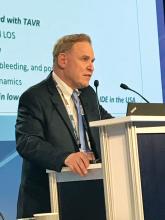WASHINGTON – , according to results of the first U.S. study to evaluate mortality in a low-risk population.
Other complications were also low relative to those seen in previously published studies with higher-risk populations. The preliminary results are “reassuring,” Ronald Waksman, MD, associate director of the division of cardiology, Medstar Health Institute, Washington, DC, reported at CRT 2018 sponsored by the Cardiovascular Research Institute at Washington Hospital Center.
The full enrollment of 200 patients has been reached in the main arm of the Low Risk TAVR study, which is evaluating tricuspid TAVR. A second study arm evaluating bicuspid TAVR is still enrolling. The 30-day outcomes data presented at the CRT meeting were restricted to the first 125 patients enrolled.In this study, a low-risk eligibility criterion is a Society of Thoracic Surgeons score of 3% or less. The mean score in the first 125 patients was 1.9%.
At 30 days, there were no myocardial infarctions, no acute kidney injuries of stage II or greater, and no transient ischemic attacks. There was one nondisabling stroke, one paravalvular leak, and one coronary obstruction that required a coronary artery bypass graft. The rates of new onset atrial fibrillation, major vascular complications, and life-threatening or major bleeding events were lower than 5%.
Surgical atrial valve replacement (SAVR) currently has a IB recommendation for the treatment of symptomatic low-risk aortic stenosis, but TAVR is not currently indicated in this population, according to 2017 American Heart Association/American College of Cardiology guidelines. There is, however, substantial interest in extending TAVR to a low-risk population, according to Dr. Waksman.
“We know that there are potential benefits for TAVR versus SAVR that include reduced ICU and hospital length of stay, more rapid quality of life recovery, lower risk of bleeding, and lower risk of postprocedure AF [atrial fibrillation],” said Dr. Waksman in explaining the rationale for this and other ongoing studies testing TAVR in low-risk patients.


